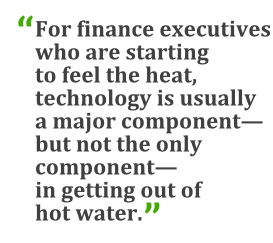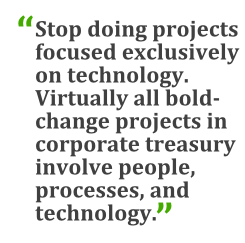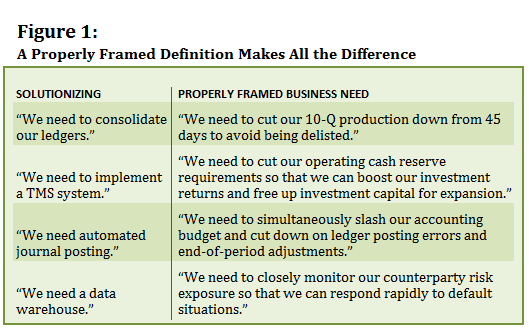 If you throw a frog into a pot of boiling water, he'll jump out. If you put the same frog in tepid water and slowly turn up the heat, you will get a very different result.
If you throw a frog into a pot of boiling water, he'll jump out. If you put the same frog in tepid water and slowly turn up the heat, you will get a very different result.
Many CFOs and corporate treasurers in the United States today—especially CFOs and treasurers of multinational corporations—find themselves in the situation of the slow-boiling frog. The technologies and workflows that their organization has used for years are unable to keep pace with both business-as-usual activities and escalating disruptive events such as a bank or trading-counterparty default, legal judgments or fines, a currency devaluation, a fraud event, a qualified audit result, or a merger or acquisition.
Who has time for strategic planning when you are constantly fighting fires? Yet for many companies, no single disruptive event has been dramatic enough to prod the finance function to jump out of the boiling water and into a more efficient way of doing things.
Since passage of the Sarbanes-Oxley Act in 2002, the landscape for finance departments has changed significantly. Numerous new regulations on financial services have hit not just financial institutions, but virtually all U.S. companies that conduct business in multiple jurisdictions. Cash transactions with non-U.S. counterparties are subject to much tighter scrutiny; opening foreign bank accounts requires increasing manual compliance efforts; Basel III is placing increasing pressure on reserve requirements; the maze of Dodd-Frank rules and regulations, including stress-testing, is affecting every company that has excess cash to invest; and the Foreign Account Tax Compliance Act (FATCA) and foreign tax reporting rules are ballooning compliance requirements worldwide. Meanwhile, ultra-low interest rates are pushing treasurers to chase yield around the globe, which places a heavy burden on risk management teams.
These challenges are exaggerated by the decentralized, non-standardized technology infrastructure in place at many companies. While it may have done a decent job of supporting the finance function a decade ago, the finance infrastructure in many organizations has reached the crisis point. Finance managers seem to be sitting in a pot of slowly boiling water: So much needs fixing that it's hard to break away from the daily grind and figure out where to start.
The situation will likely get worse before it gets better. Making improvements, preparing the company and the finance department for disruptive events, and reducing costs in the current compliance environment require bold strokes and risk taking—and CFOs are notoriously risk-averse.
Signs That Something Needs to Change
There are a number of characteristics of infrastructure design that are highly inefficient but are all too common in today's finance function. One is having a plethora of disbursement and receipt systems scattered throughout subsidiaries, each with its own bank integration. Another is the use of multiple general ledger systems, which makes consolidation to support quarter-end financial statements extremely time-consuming. CFOs usually inherit these situations from a slew of acquisitions or global expansion.
 Many companies also use multiple small treasury management systems, each of which may handle a very specific treasury function such as cash management or forecasting. Likewise, most companies run multiple reconciliation systems, which are often application-specific, as well as numerous financial reporting systems that do not cross-tie. In this environment, exceptions are often handled by several groups throughout the company, and financial data is dispersed across many applications rather than being stored in a single data warehouse or data hub in the cloud. All of these factors create a risk of data inconsistencies and slow down finance department processes.
Many companies also use multiple small treasury management systems, each of which may handle a very specific treasury function such as cash management or forecasting. Likewise, most companies run multiple reconciliation systems, which are often application-specific, as well as numerous financial reporting systems that do not cross-tie. In this environment, exceptions are often handled by several groups throughout the company, and financial data is dispersed across many applications rather than being stored in a single data warehouse or data hub in the cloud. All of these factors create a risk of data inconsistencies and slow down finance department processes.
Companies running multiple underlying payment-initiation systems, each with separate approval and workflow policies, are putting themselves at risk of fraud, error, and increased transactional costs. Finally, many organizations handle risk management via spreadsheets and email. This approach impedes the CFO's ability to react quickly and cautiously to disruptive events.
Moving toward more efficient operations in a multinational business generally entails a factoring process—identifying everywhere that different teams around the firm are handling the same process using the same or similar tools, and consolidating their efforts. Examples include replacing multiple disbursement and receipt systems with a single system utilizing a central messaging bus with consolidated exception management; replacing multiple general ledger systems with a single ledger or a ledger-consolidation facility; and replacing Excel with a consolidated credit risk exposure reporting platform that provides intraday currency and counterparty exposure calculations. And it may entail deployment of an enterprise-wide treasury management system that communicates with the banking community and with other finance system components. Such a technology infrastructure can dramatically increase the efficiency of the finance department, substantially reducing the time required to close the quarter, and can reduce the chance of errors.
Bear in mind that technology changes are not a panacea. For example, ledger consolidation is not the right approach for every organization. Some companies choose, for strategic reasons, to keep their accounting functions segregated to help make their business units more agile or to facilitate spin-offs. Companies that choose not to take the leap onto a single companywide general ledger can harvest other low-hanging fruit, such as using a standardized chart of accounts across multiple ledgers, implementing a centralized journal-posting facility and ledger reconciliation system, or introducing a consolidation layer that brings together the business units' various ledgers onto a common platform.
One large insurance company, for example, cut its 10-Q/10-K production time in half by introducing a ledger consolidation and reconciliation system on the investment side. But this same company has the opportunity to do even better if it will attack the operating side with equal vigor. For large companies with many regional subsidiaries, these undertakings carry daunting project risks.
Getting Started
Remaking the finance infrastructure usually requires major technology rejiggering. Many finance functions are too tied up in the day-to-day to step back and determine better ways of doing things. How can a finance management team know if their operations and technology are up to snuff?
The corporate finance department covers a broad swath of responsibilities, but a subset of these functions lend themselves well to evaluation against best-practices benchmarks. Some treasury activities that can be readily benchmarked include:
- cash/bank reconciliation,
- payment and bank account management processes,
- cash positioning,
- cash forecasting,
- foreign exchange and currency exposure management,
- intercompany loans and letters of credit,
- investments and debt management, and
- accounting.
The ideal way to determine whether you need to take a big leap out of a boiling infrastructure is to engage a third party to benchmark one or more of these activities against best practices. Working with an independent firm that has deep industry knowledge but has no vested interest in the study's outcome helps ensure that the benchmarking process is effective.
Once the benchmark study is complete, finance managers can develop a business case that quantifies the benefit of bridging any gaps that the study reveals. Note that the areas of improvement that offer the highest return on investment (ROI) may not necessarily be the company's first choice of a project. Decisions about which areas to tackle first should consider project duration and project risk as well as returns. After you complete a project designed to close gaps exposed by the study, consider doing an identical, follow-up study to see if you have actually reduced the gaps.
For those areas of the finance department that do not lend themselves to benchmarking, such as shortening the quarterly close cycle, fraud reduction, and regulatory compliance, the key is to develop a sound business case that has a clear ROI before getting started with a project.
Tips and Techniques
After establishing that a prospective project's risks and ROI make it worth pursuing, the project team is ready to get started. The following rules of thumb are well worth considering for finance or treasury managers who want to ensure their company is successfully moving down the right path:
Stop doing projects focused exclusively on technology. Virtually all bold-change projects in corporate treasury involve people, processes, and technology. Technology is just one aspect, and it should not solely drive strategy decisions. All too often technology projects are dominated by what a vendor product does, rather than the customer's specific business needs, and so the technology component of the project takes on a life of its own. Let's say your treasury management system has a dozen major features but your ROI analysis suggests you need only three of them. The other nine functions may seem “free,” but they usually entail high implementation costs and divert staff attention away from the company's core needs.
Focus on the business problem. If you frame the business problem and the ROI clearly, the solution usually jumps out. Figure 1, below, shows some common examples of “solutionizing”—overemphasizing the technology side of the equation—versus properly framing the business need driving the initiative. When business definitions are properly framed and metrics are quantified, the optimal solution may vary greatly from what may initially seem to be the obvious approach.
Every problem that a CFO has ever faced has probably vexed someone before you, and it has been solved. Being an active participant in a peer network and/or soliciting outside help from the consulting community (at least for a road map) can go a long way toward both clearly articulating the business problem and developing a solution.
Perform proofs of concept as needed. There's nothing more useful than a properly framed proof of concept (POC) to mitigate project risk. But a POC is very difficult to perform correctly. The POC is designed specifically to convert each unknown element into a well-understood element. Some generic examples of typical unknowns that are serious red flags include a new, untested project team; a new vendor product; and/or a new technology tool set. Your POC should involve your new project team in delivering something small but usable. The POC should include installing and implementing the new product on a limited scale to see how the vendor's implementation team gels with your team, and whether the product does what the vendor claims it does. And finally, it should enable you to try your technology tool set on a very small scale. We know of one large mutual fund company that introduced new standards for its entire development infrastructure, only to discover after the fact that the change slowed down development by about 90 percent.

Follow best practices in technology infrastructure design. While we like to avoid solutionizing, there are certainly some techniques that fare better than others.
- Avoid point-to-point (PTP) system integration. Instead, build a message bus and/or a data hub. PTP is easier to build initially, but it's very expensive to maintain in the long term. In addition, PTP makes it far more expensive to perform an impact analysis on disruptive events such as a divestiture, acquisition, or implementation of a major application such as a general ledger, ERP system, or treasury management system.
- Keep your key applications up to date with the latest versions. Failing to upgrade may result in lost vendor support for the product. Upgrading also improves your ability to pick up new modules from your vendors as they become available or as needs arise.
- Try to select “open” products that make software upgrades, data management, and data replication easier and less expensive. Consider various deployment options, including private cloud hosting to reduce internal strain and outsourcing of services required to maintain the product (e.g., upgrades).
- Embed a workflow management tool across various systems for areas like treasury and payments. The workflow tool can streamline tasks such as opening accounts and initiating and approving wire payments, and it can provide a full audit trail for these activities.
- Work with a vendor to provide SWIFT integration and ongoing management of the SWIFT relationship. There's a high price tag to maintain new SWIFT features and the sheer volume of message types on an in-house basis.
- Implement an automated work distribution facility that can route tasks automatically across time zones or operations shifts to efficiently balance the workload.
- Consider integrating reference-data databases that can significantly streamline or virtually eliminate manual bank setup for payments and settlement instructions.
Above all, when considering the purchase of a solution or performing data integration, remember that business conditions will change quickly. Your solutions and your data-integration layer need to be flexible enough to deal with changes rapidly and with minimal operational disruption.
Additional Considerations
For finance executives who are starting to feel the heat, technology is usually a major component—but not the only component—in getting out of hot water. Often, quick hits can be achieved by focusing on business processes and staffing, with technology changes following an organizational restructuring.
For example, wouldn't you get a better currency conversion rate and much lower transaction costs by replacing 1,000 transactions for $10,000 each with two transactions for $5 million each? As another example, the corporate finance department would clearly have better controls on opening and closing of bank accounts if one “center of excellence” in each major geographic region handled bank account administration, rather than having 25 local subsidiaries each managing its own accounts.
In working to get out of the boiling pot, finance should focus on whatever it takes to improve the bottom line; a strategic approach almost always involves some combination of staff reorganization, process improvements, and technology. And taking a sustainable and strategic approach to both process reengineering and technology implementation can make all the difference. It can keep the frog out of the pot and help the CFO focus on the bold moves required for long-term stability and growth.
—————————————-
 Berl Kaufman is a senior manager with SunGard Consulting Services. A veteran consultant, Berl provides a deep perspective on both business and technical concerns facing executive management today. He has spoken at conferences on client reporting, collateral management, and reconciliation, and has published papers on diverse topics ranging from data management to hedge fund operations and total quality management (TQM).
Berl Kaufman is a senior manager with SunGard Consulting Services. A veteran consultant, Berl provides a deep perspective on both business and technical concerns facing executive management today. He has spoken at conferences on client reporting, collateral management, and reconciliation, and has published papers on diverse topics ranging from data management to hedge fund operations and total quality management (TQM).
© Touchpoint Markets, All Rights Reserved. Request academic re-use from www.copyright.com. All other uses, submit a request to [email protected]. For more inforrmation visit Asset & Logo Licensing.



